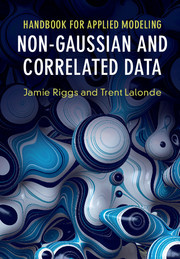Description
Handbook for Applied Modeling: Non-Gaussian and Correlated Data
Authors: Riggs Jamie D., Lalonde Trent L.
This compact, entry-level Handbook equips applied practitioners to choose and use core models for real-world data - with R and SAS.
Language: English
Subject for Handbook for Applied Modeling: Non-Gaussian and...:
Approximative price 119.03 €
In Print (Delivery period: 14 days).
Add to cart
Handbook for Applied Modeling: Non-Gaussian and Correlated Data
Publication date: 07-2017
228 p. · 18.1x26.1 cm · Hardback
Publication date: 07-2017
228 p. · 18.1x26.1 cm · Hardback
Approximative price 45.81 €
In Print (Delivery period: 14 days).
Add to cart
Handbook for Applied Modeling: Non-Gaussian and Correlated Data
Publication date: 07-2017
228 p. · 17.8x25.4 cm · Paperback
Publication date: 07-2017
228 p. · 17.8x25.4 cm · Paperback
Description
/li>Contents
/li>Biography
/li>
Designed for the applied practitioner, this book is a compact, entry-level guide to modeling and analyzing non-Gaussian and correlated data. Many practitioners work with data that fail the assumptions of the common linear regression models, necessitating more advanced modeling techniques. This Handbook presents clearly explained modeling options for such situations, along with extensive example data analyses. The book explains core models such as logistic regression, count regression, longitudinal regression, survival analysis, and structural equation modelling without relying on mathematical derivations. All data analyses are performed on real and publicly available data sets, which are revisited multiple times to show differing results using various modeling options. Common pitfalls, data issues, and interpretation of model results are also addressed. Programs in both R and SAS are made available for all results presented in the text so that readers can emulate and adapt analyses for their own data analysis needs. Data, R, and SAS scripts can be found online at http://www.spesi.org.
1. The data sets; 2. The model-building process; 3. Constance variance response models; 4. Non-constant variance response models; 5. Discrete, categorical response models; 6. Counts response models; 7. Time-to-event response models; 8. Longitudinal response models; 9. Structural equation modeling; 10. Matching data to models.
Jamie D. Riggs is an adjunct lecturer in the Predictive Analytics program at Northwestern University, Illinois. She specializes in the statistical issues of solar system cratering processes, solar physics, and galactic dynamics, and has collaborated with researchers at the Los Alamos National Laboratory, New Mexico and the Southwest Research Institute, Texas. She has held technical and managerial positions at Sun Microsystems, Inc., National Oceanic and Atmospheric Administration, and the Boeing Company, where she applied advanced statistical designs and analyses to manufacturing and business problems. She is the Solar System and Planetary Sciences Section Head of the International Astrostatistics Association.
Trent L. Lalonde is Associate Professor of Applied Statistics at the University of Northern Colorado, and Director of the University's Research Consulting Lab. He has spent a number of years designing and teaching graduate courses covering statistical methods for students in diverse areas such as special education, psychological sciences, and public health. In addition, he has helped direct dissertations in these areas, and has consulted with numerous faculty on publications and funding proposals. He has received awards for both instruction and advising, and has Chaired the Applied Public Health Statistics section of the American Public Health Association.
Trent L. Lalonde is Associate Professor of Applied Statistics at the University of Northern Colorado, and Director of the University's Research Consulting Lab. He has spent a number of years designing and teaching graduate courses covering statistical methods for students in diverse areas such as special education, psychological sciences, and public health. In addition, he has helped direct dissertations in these areas, and has consulted with numerous faculty on publications and funding proposals. He has received awards for both instruction and advising, and has Chaired the Applied Public Health Statistics section of the American Public Health Association.
© 2024 LAVOISIER S.A.S.




